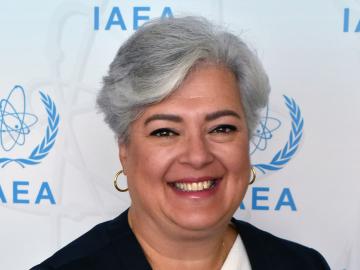
Filter News
Area of Research
News Type
News Topics
- 3-D Printing/Advanced Manufacturing (5)
- Advanced Reactors (1)
- Bioenergy (7)
- Biology (6)
- Biomedical (1)
- Buildings (2)
- Chemical Sciences (2)
- Clean Water (2)
- Climate Change (6)
- Composites (1)
- Computer Science (2)
- Cybersecurity (2)
- Decarbonization (7)
- Energy Storage (1)
- Environment (11)
- Grid (2)
- High-Performance Computing (1)
- Machine Learning (1)
- Materials (3)
- Materials Science (4)
- Mercury (2)
- Microscopy (5)
- Nanotechnology (1)
- National Security (5)
- Net Zero (2)
- Nuclear Energy (5)
- Physics (2)
- Polymers (2)
- Simulation (1)
- Sustainable Energy (5)
- Transportation (4)
Media Contacts

Countries around the world have unique languages, cultures, food, entertainment and governments. Yet, more than 170 countries are finding common ground in an unlikely field: nuclear material and science.

Oak Ridge National Laboratory physicist Elizabeth “Libby” Johnson (1921-1996), one of the world’s first nuclear reactor operators, standardized the field of criticality safety with peers from ORNL and Los Alamos National Laboratory.

When Matt McCarthy saw an opportunity for a young career scientist to influence public policy, he eagerly raised his hand.

Cameras see the world differently than humans. Resolution, equipment, lighting, distance and atmospheric conditions can impact how a person interprets objects on a photo.

Chemical and environmental engineer Samarthya Bhagia is focused on achieving carbon neutrality and a circular economy by designing new plant-based materials for a range of applications from energy storage devices and sensors to environmentally friendly bioplastics.

Mechanical engineer Marm Dixit’s work is all about getting electricity to flow efficiently from one end of a solid-state battery to the other. It’s a high-stakes problem

Though Nell Barber wasn’t sure what her future held after graduating with a bachelor’s degree in psychology, she now uses her interest in human behavior to design systems that leverage machine learning algorithms to identify faces in a crowd.

Science has taken Melanie Mayes from Tennessee to the tropics, studying some of the most important ecosystems in the world.

Friederike (Rike) Bostelmann, who began her career in Germany, chose to come to ORNL to become part of the Lab’s efforts to shape the future of nuclear energy.

How an Alvin M. Weinberg Fellow is increasing security for critical infrastructure components


